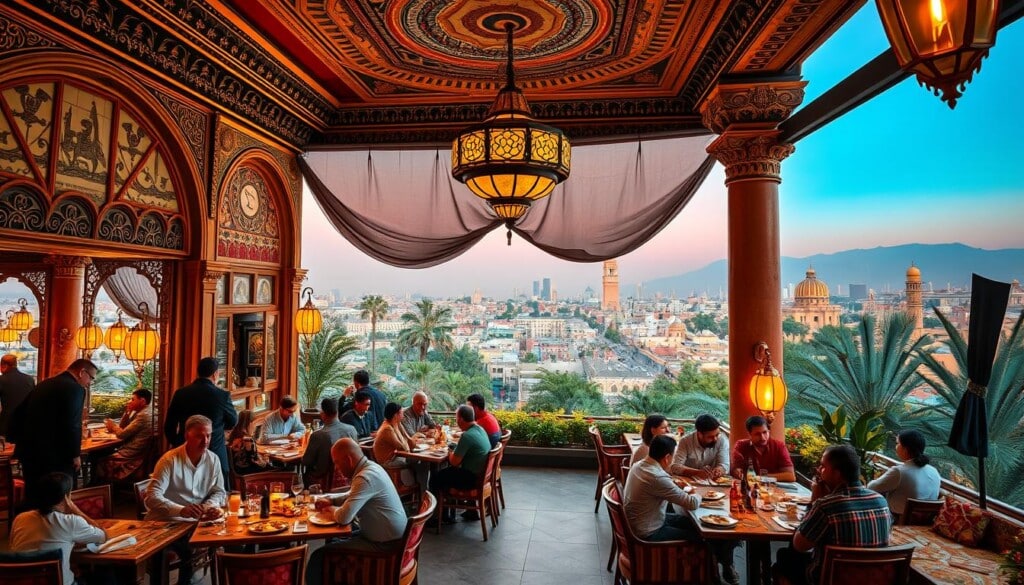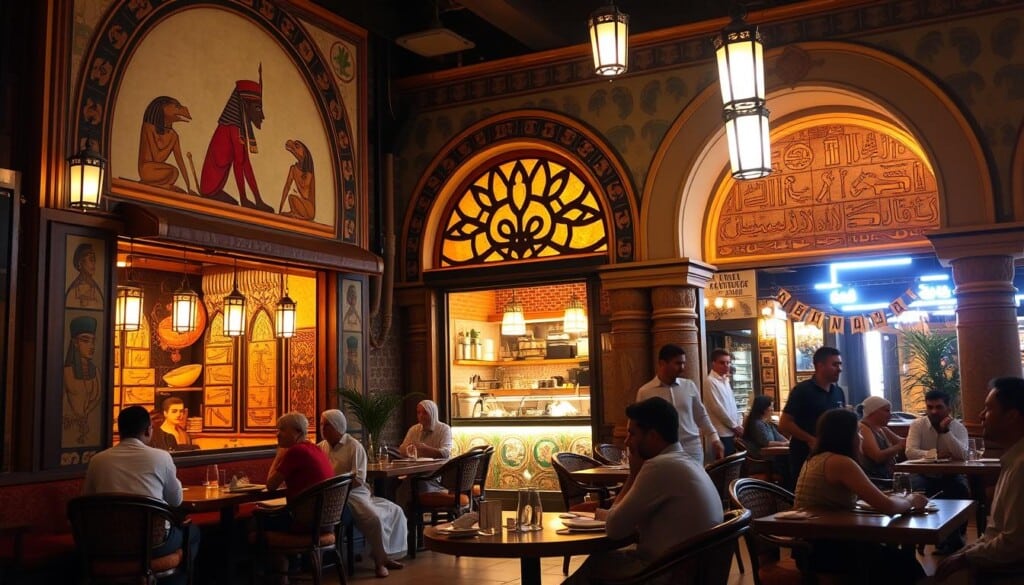Ever wondered why Egyptian food restaurants is winning hearts in the U.S.? More people are trying Egyptian food, drawn by its rich flavors and traditions. Each dish is a story, blending history and culture.
This guide will show you the best Egyptian restaurants. We’ll highlight what makes dining there special. Plus, we’ll point out top spots in major cities. Get ready to explore authentic flavors and see why Egyptian food is a hit in America.
Key Takeaways
- Egyptian cuisine’s rich flavors are gaining popularity in the U.S.
- Top Egyptian food spots offer unique dining experiences.
- The cultural significance of traditional dishes enhances their appeal.
- Explore diverse ingredients that define Egyptian cooking.
- Experience the fusion of history and flavor in every meal.
The Rich Heritage of Egyptian Cuisine
Egyptian cuisine has a deep history, shaped by many cultures over time. The Coptic and Ottoman eras have left their mark on Egyptian food. These influences have made Egyptian dishes unique and flavorful.
Historical Influences on Egyptian Food
Egypt’s food history is rich and varied. The Coptic era focused on local ingredients like lentils and veggies. The Ottoman era brought strong spices, creating the tasty Middle Eastern dishes we love today.
This mix of cultures has made Egyptian food vibrant and exciting. It delights food lovers and experts alike.
Popular Ingredients in Egyptian Dishes
Key ingredients in Egyptian food include rice, lentils, and spices. These items are the foundation of many dishes, making them healthy and balanced. Herbs and fresh veggies add depth and flavor.
For those eager to try these dishes, finding local Egyptian restaurants is a great idea.
Unique Cooking Techniques
Egyptian cooking is an art, with special techniques that showcase its traditions. Slow-cooking stews blend flavors beautifully, while grilling meats highlights their natural taste. These methods keep dishes authentic and enhance their flavor.
Through these techniques, Egyptian food stands out, giving diners a true taste of Egypt’s heritage.
Top Egyptian Food Restaurants in Major Cities
Exploring the best Egyptian restaurants across major U.S. cities shows a rich mix of flavors and traditions. Each place is known for its exceptional dishes. From New York City to Los Angeles and Chicago, these spots serve delicious meals and capture the essence of Egyptian cuisine.
New York City: A Taste of Cairo
In New York City, Mombar is a top spot for Egyptian food lovers. It offers a wide range of traditional dishes like koshari and stuffed pigeons. The flavors are rich, making diners feel like they’re in Cairo. It’s great for a casual night or a special occasion.
Los Angeles: Savoring Egyptian Delicacies
Los Angeles is home to Kenz, known for its organic and fresh ingredients. The restaurant focuses on traditional Egyptian flavors. You can enjoy dishes like shawarma and baba ghanoush. Kenz’s quality attracts both locals and tourists, making it a welcoming place to dine.
Chicago: Experience Authentic Egyptian Flavors
Chicago has Egyptian Kitchen, loved for its home-style cooking and family-friendly service. The menu features Egyptian comfort food like molokhia and fata. It’s a favorite among locals and visitors alike, making it a top choice in the area.

Must-Try Dishes in Egyptian Cuisine
Exploring Egyptian cuisine reveals dishes with unique tastes and cultural importance. These dishes show the heart of Egyptian comfort food. They highlight the variety of ingredients and cooking methods that make this cuisine special.
Koshari: The Quintessential Egyptian Comfort Food
Koshari is Egypt’s most beloved comfort food. It’s a mix of lentils, rice, and pasta, topped with spicy tomato sauce. Crispy onions add a nice crunch. It’s a dish that brings people together, loved by both locals and tourists.
Fatta: A Traditional Feast for Celebrations
Fatta is a key dish at festive events. It has layers of rice, meat, and fried bread, all in a tangy garlic sauce. It’s not just food; it’s a symbol of unity and joy in Egyptian culture.
Molokhia: A Flavorful Greens Dish
Molokhia is famous for its taste and health benefits. It’s served with rice and chicken. Made from jute plant leaves, it’s a true example of Egyptian cuisine’s richness. Its unique flavor and texture make it a favorite among many.
How to Find Egyptian Food Restaurants Near You
Exploring Egyptian food restaurants is an exciting journey for food lovers. Local food directories, like LocalZ, make it easy. They help you find a variety of Egyptian dishes near you.
Utilizing Online Directories like LocalZ
Online directories are great for finding Egyptian food restaurants. LocalZ offers a detailed platform. It lets you search by location and cuisine type, making it easy to find the best spots.
Searching for Authentic Reviews and Recommendations
Reading real reviews is key to finding top dining spots. LocalZ’s user experiences offer valuable insights. They help you choose the best places for a great meal.

The Role of LocalZ in Discovering Egyptian Cuisine
LocalZ is key in changing how we find local food, like Egyptian cuisine. It’s an online directory that helps people find and support local eateries. By making it easy to find restaurants, LocalZ boosts the local economy and brings people together through food.
Enhancing Community Engagement with Local Businesses
LocalZ lets restaurants connect with their community in a big way. It’s easy for customers to share their thoughts and experiences. This builds trust and loyalty, which are vital for success in the food world.
Benefits of Listing Your Restaurant on LocalZ
Listing on LocalZ gets your restaurant noticed in the area. You can show off your menu and special deals. It’s a smart move in today’s digital age to attract more customers. Plus, it helps build a strong community around local food.
Booking a Table: What You Need to Know
When you dine at popular Egyptian restaurants, knowing how to book a table is key. Many places prefer reservations, mainly during busy times and weekends. This ensures you get a table and enjoy your meal without delays.
Today, booking restaurants online is easy. You can check availability and make plans ahead of time. This makes planning your meal out a breeze.
Online Reservations vs. Walk-Ins
Online reservations save time and avoid long waits. Restaurants use systems to handle requests quickly. Walk-ins are also welcome, but you might face longer waits.
Knowing a restaurant’s preference helps. You can decide whether to book ahead or just go.
Tips for a Great Dining Experience
Good dining tips can make your experience better. Arriving on time for reservations is important. It helps the service start smoothly.
Learning about the menu can lead to interesting talks with the staff. Asking for recommendations shows you’re curious. It might help you find new favorite dishes.
Following these tips can make your dining experience unforgettable. Enjoy the warm atmosphere of Egyptian cuisine.
Supporting Local Businesses Through Egyptian Cuisine
Eating local Egyptian food is not just tasty. It also helps the economy a lot. When you choose to eat at places that serve real Egyptian dishes, you help create jobs. Every meal you have at a local spot helps make the area more stable financially.
Community events are key to strengthening local ties. Food festivals and pop-ups focused on Egyptian cuisine bring people together. These events show off cultural pride and unity.
They give local chefs a chance to share their talents. By celebrating African flavors and traditional recipes, we learn and appreciate more. This helps everyone in the community grow closer.
If you want to bring more Egyptian culture to your area, join local initiatives. Sites like LocalZ help you connect with others. By participating, you support local businesses and add to the community’s rich heritage.
Reviews and Ratings: Importance for Restaurants
In the competitive world of restaurants, reviews and feedback are key. They help diners make smart choices and give owners a chance to get better. Positive feedback and ratings are vital for restaurants, showing their strengths and areas for growth.
Understanding Customer Feedback
Feedback from customers offers deep insights into food, service, and atmosphere. People share their experiences, pointing out what’s good and what needs work. This helps restaurants improve and make dining better for everyone.
How to Leave a Meaningful Restaurant Review
Writing a good review means being clear and specific. Think about taste, presentation, service, and atmosphere. Mentioning favorite dishes or great service helps others. Sharing feedback helps restaurants get better, showing how ratings matter.

LocalZ: Connecting You with Egyptian Food Restaurants
LocalZ is a key online tool that helps people find Egyptian food restaurants near them. It makes it easy to search by location or cuisine type. Users can read reviews and even order food, making dining out simple and enjoyable.
Easy Steps to Get Started with LocalZ
To start with LocalZ, just create an account or explore the directory. The site is easy to use, with filters to help find what you’re looking for. By setting your preferences, LocalZ shows you a list of restaurants with all the important details.
This makes it easy for everyone to try the delicious Egyptian dishes available.
The Impact of LocalZ on Community Support
LocalZ does more than just connect people with restaurants. It also helps local communities by giving a part of its fees to local groups. This helps the food scene and the local economy grow by building strong ties between businesses and their areas.
By using LocalZ, people help support a culture of teamwork that’s essential for local businesses to thrive.

